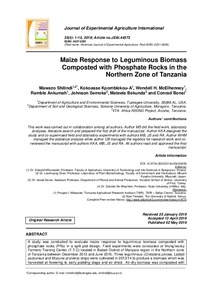| dc.contributor.author | Shitindi, M. |
| dc.contributor.author | Kpomblekou-A, K. |
| dc.contributor.author | McElhenney, W.H. |
| dc.contributor.author | Ankumah, R. |
| dc.contributor.author | Semoka, J. |
| dc.contributor.author | Bekunda, Mateete A. |
| dc.contributor.author | Bonsi, C. |
| dc.date.accessioned | 2019-12-04T11:33:47Z |
| dc.date.available | 2019-12-04T11:33:47Z |
| dc.date.issued | 2019-05-02 |
| dc.identifier.citation | Shitindi, M., Kpomblekou-A, K., McElhenney, W.H., Ankumah, R., Semoka, J., Bekunda, M. & Bonsi, C. (2019). Maize response to leguminous biomass composted with phosphate rocks in the northern zone of Tanzania. Journal of Experimental Agriculture International, 35(4), 1-15. |
| dc.identifier.issn | 2457-0591 |
| dc.identifier.uri | https://hdl.handle.net/20.500.12478/5807 |
| dc.description.abstract | A study was conducted to evaluate maize response to leguminous biomass composted with phosphate rocks (PRs) in a split plot design. Field experiments were conducted at Wang’waray Farmers Training Center (F.T.C) located in Babati District of Manyara region in the Northern zone of Tanzania between December 2013 and June 2015. Three leguminous (Crotalaria juncea, Lablab purpureus and Mucuna pruriens) strips were cultivated in 2013/14 to produce a biomass which was harvested at flowering to early podding stage and air dried. Air-dry biomass was composted with PRs from Minjingu (medium reactive PR) and Panda Hill (low reactive PR). Maize response to different treatments was evaluated across the field strips in 2014/15 season. The strips previously used to produce leguminous biomass were used as main plots and each strip was divided into seven subplots receiving different treatments at random. A medium term maize variety SC. 627 was used as a test crop. Average maize grain yields obtained from Crotalaria, Lablab and Mucuna strips reached 5.3, 4.5 and 4.0 t ha-1, respectively and were statistically different (P=.05). Application of Minjingu or Panda Hill PR alone didn’t increase maize grain yield above the control while Minjingu PR applied with urea or composted with biomass increased maize grain yield by 2.40 and 1.58 t ha-1, respectively above the control. Application of Panda Hill PR with urea or composted with biomass increased grain yield by 1.20 and 1.06 t ha-1, respectively above the control. The observed differences (0.82 and 0.14 t ha-1) were not statistically significant indicating that biomass composted with PR was as effective as the PR applied with urea. |
| dc.description.sponsorship | United States Agency for International Development |
| dc.format.extent | 1-15 |
| dc.language.iso | en |
| dc.rights | Copyrighted; all rights reserved |
| dc.subject | Lablab |
| dc.subject | Mucuna |
| dc.subject | Rock Phosphate |
| dc.subject | Composts |
| dc.subject | Maize |
| dc.subject | Yields |
| dc.title | Maize response to leguminous biomass composted with phosphate rocks in the northern zone of Tanzania |
| dc.type | Journal Article |
| dc.description.version | Peer Review |
| cg.contributor.crp | Maize |
| cg.contributor.affiliation | Tuskegee University |
| cg.contributor.affiliation | Sokoine University of Agriculture |
| cg.contributor.affiliation | International Institute of Tropical Agriculture |
| cg.coverage.region | Africa |
| cg.coverage.region | East Africa |
| cg.coverage.country | Tanzania |
| cg.creator.identifier | Mateete Bekunda: 0000-0001-7297-9383 |
| cg.researchtheme | NATURAL RESOURCE MANAGEMENT |
| cg.authorship.types | CGIAR and developing country institute |
| cg.iitasubject | Maize |
| cg.iitasubject | Natural Resource Management |
| cg.journal | Journal of Experimental Agriculture International |
| cg.howpublished | Formally Published |
| cg.accessibilitystatus | Limited Access |
| local.dspaceid | 105212 |
| cg.targetaudience | Scientists |
| cg.identifier.doi | https://dx.doi.org/10.9734/jeai/2019/v35i430209 |

